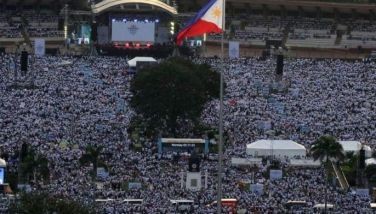Undas is a Filipino fiesta

For Filipino Catholics, the proper day to visit the graves of their deceased loved ones is actually on Nov. 2 which is All Souls’ Day. This is supposed to be a day of mourning for the dead. There should be no parties or merrymaking on that day.
On Nov. 1, All Saints’ Day, the Catholic Church celebrates the Feast of All Saints’ Day. In the Philippines the term for this day is Undas. There are different stories of the origin of this Tagalog word. The story I like best is that the word undas is derived from the Spanish word honra meaning respect. In this context, the word refers to “respect for the dead.”
Certain aspects of celebrating these two days have changed. However, the core celebration has remained the same. In the October-November 1941 issue of the Cenacle Missionary, there was an article on how this Filipino custom was celebrated.
“An old Christian custom bids us to visit the graves of our dead on All Souls’ Day or even already on the afternoon of All Saints’ Day. In Manila, this day is celebrated, yes even very solemnly, with oriental gaiety and colorful bustle seemingly quite irreverent and improper to occidental minds. On All Saints’ Day special traffic regulations have to be put in force on the streets and lanes leading to the cemeteries.
Early in the afternoon the migration to the cemeteries already begins, but the main traffic sets in the evening after sunset, and continues throughout the entire night. The Filipinos are holding their vigil of the dead. “To be sure, they do not pray the ecclesiastical nocturnes. They provide themselves with food and drink, with cakes and cookies and ice cream, and thus by flickering candlelight, they watch the whole night at the graves of their beloved dead.”
Today, because of the terrible traffic situation, visitors to cemeteries can be seen going to cemeteries days before undas. While many still bring food, the presence of fast food kiosks in cemeteries have become the principal source of food. Finally, candles, along with flowers, mainly serve as decorations for graves and not for lighting.
The durability of this tradition can be attributed to the fact that undas is both a religious and cultural tradition for Filipinos. In his book “Culture and Community in the Philippine Fiesta and Other Celebrations,” Florentino H. Hornedo wrote that celebrations and specialty fiestas endure in this country because “...it is rooted in the communitarian and expressive instincts of human nature...it is a durable venue for Filipino cultures and expressions...and is a symbol of Filipino sense of community.”
Hornedo sees Philippine fiestas as a cultural anchor helping the Filipinos define their national character: “It is to this small community, that is annually recreated by the fiesta that he goes home to renew his identity and sense of belonging – belonging to a home and familial village.”
This seems to be the best explanation why the Filipino goes home every Christmas and Holy Week. The memory of ways of celebrating Catholic feasts is evidence that there is a distinct Filipino culture that serves to bond us all together as one people.
No matter in what corner of the world we may be, we remain truly Filipino.
Origin of All Saints’ and Souls’ Days
All Saints’ Day traces its beginnings to the Feast of All Holy Martyrs introduced by Pope Boniface IV. On May 13, 615 AD, he dedicated the ancient Roman temple of Pantheon as a church to the Blessed Virgin Mary and all the martyrs of the Church.
In 844 AD, Pope Gregory IV transferred the celebration to Nov. 1 because he felt that after the harvest season, it would be easier to feed the many pilgrims who came to visit Rome. Finally in 1484 AD Pope Sixtus IV established All Saints’ Day as a holy day of obligation to honor the large number of martyrs who could not be accorded the honor of a special feast day.
All Souls’ Day was established as a Church-wide commemoration day for praying for the dead. In 1048 AD, St. Odilo, the Abbot of Cluny decreed that all monasteries of the congregation of Cluny were to annually keep Nov. 2 as a “ Day of All Departed Ones.” The observance of the Benedictines of Cluny was soon adopted by other Benedictines.
It took around three hundred years to spread throughout Europe. Finally in the 14th century, Rome officially made Nov. 2 as the official day for the commemoration of “all the faithful departed.” The date was chosen so that the memory of all the “holy spirits,” both the saints in heaven and the souls in purgatory should be celebrated on two successive days.
This day of praying for the dead is tied to the Catholic Church’s belief that not everyone who “dies in God’s grace” is ready to go to heaven. In order to prepare them for the Beatific Vision – direct experience with God and His perfect nature- they must be purified of “ lesser faults of venial sins.” This stage of purification, prior to entering Heaven is called Purgatory. Catholics believe that the prayers and mass offerings of the living will benefit those who are dead and are still in Purgatory. All Souls’ Day is a day for saying requiem masses and praying novenas for the souls of our beloved ones who may still be in Purgatory..
Creative writing classes for kids, teens, adults
Young Writers’ Hangout on Nov. 10 and 24 (1:30 p.m.-3 p.m.; stand-alone sessions), writing in the workplace with Ginny Santiago on Nov. 17 (1:30-4:30 pm) at Fully Booked BGC. For details and registration, email [email protected].
Email:[email protected]
- Latest
- Trending




























